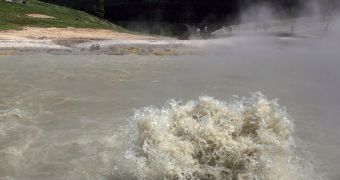University of Chicago investigators, led by researcher Albert Colman, are currently testing out a variety of theories on how ancient Earth's climate looked like. They are carrying out the study in a peculiar ecosystem, consisting of hot springs in a Siberian volcanic crater.
What the team believes is that certain, uncommon bacteria may have played a role in determining the overall chemical composition of the atmosphere, hundreds of millions of years ago. But they still need proof for all this, hence the investigations.
Researchers are not trying to figure out how the atmosphere looked like at a specific point in time, but rather detect the stages through which it passed before arriving at a configuration that was more than suitable for the development of complex life.
The reason why the international research team – made up of American and Russian scientists – chose the Uzon Caldera in the eastern Siberian Kamchatka Peninsula is that the area contains bacteria displaying a rather abnormal life style.
Past investigations conducted at this location have revealed that these microorganisms both produce and consume carbon monoxide (CO). These microbes are called anaerobic carboxydotrophs, and they are renowned for having a remarkably strange physiology.
“We targeted geothermal fields believing that such environments would prove to be prime habitat for carboxydotrophs due to the venting of chemically reduced, or in other words, oxygen-free and methane-, hydrogen-, and carbon dioxide-rich volcanic gases in the springs,” Colman explains.
What captivated the science team was finding out that most of the carbon monoxide being produced at the volcanic caldera was created by the microorganisms, and not the volcano itself. This implies that microbial CO sources can be tremendously powerful.
If we translate this into an early environment, where numerous volcanoes were active at the same time, it is conceivable that the bacteria played a role in shaping Earth's atmosphere in a certain direction.
The organisms may have also contributed to triggering the Great Oxygenation Event, a natural phenomenon that saw the development of plants, and the introduction of massive amounts of oxygen in an otherwise oxygen-poor atmosphere.
“This important transition enabled a widespread diversification and proliferation of metabolic strategies and paved the way for a much later climb in oxygen to levels that were high enough to support animal life,” Colman concludes, quoted by SpaceRef.

 14 DAY TRIAL //
14 DAY TRIAL //